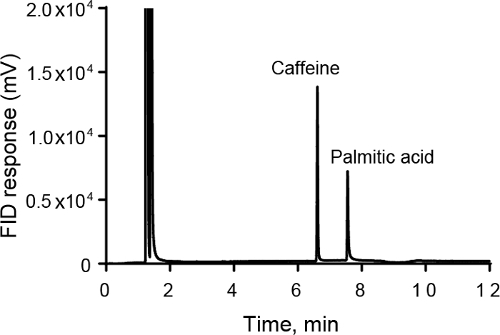气相色谱 (GC) 与火焰电离检测
资料来源: 实验室的博士 B.吉尔 Venton-弗吉尼亚大学
气相色谱 (GC) 用来分离和检测小分子化合物,在气相中。该示例是一种气体或液体蒸发在进样口。通常情况下,分析了化合物都是小于 1,000 Da,因为它很难蒸发较大的化合物。GC 是受欢迎的环境监测和工业应用的因为它是非常可靠,可以几乎连续运行。GC 通常用于在应用程序中地方小,易挥发的分子检测,并与非水溶液。高效液相色谱法测量水样中更受欢迎,可以用来研究更大的分子,因为分子不需要蒸发。而 LC 是更常见的分离极性物的 GC 青睐为非极性分子。
气相色谱流动相载气通常氦已,因为是其低分子量和化学惰性。施加压力和流动相移动通过列分析物。分离是使用涂层与固定相柱来完成的。开管毛细管柱是最受欢迎的专栏,有涂层的毛细管墙上固定相。固定相往往衍生物的聚二甲基硅氧烷,5 — — 10%的官能化来优化分离的组。典型的功能组是苯基、 氰基丙基或 trifluoropropyl。毛细管柱通常是 5-50 米长。窄列有更高的分辨率,但需要较高的压力。也可以在固定相涂在珠包装在列中用填料的塔。填料的塔是短,1-5 m.开放管状毛细血管具有一般首选因为他们允许更高的效率,更快的分析,并且有更高的能力。
火焰离子化检测 (FID) 是碳的检测样品中含量的气相色谱中有机物的良好一般探测器。后列,样品被烧热,氢空气火焰中。碳离子是由燃烧产生的。而过程的整体效率较低 (仅有 1 中 105碳离子生产中火焰离子) 的离子总量是碳的样品中含量成正比。电极用于测量从离子电流。FID 是破坏性的探测器,热解的完整示例。FID 是受不可燃气体和水。
1.初始化的气相色谱法
- 打开的氦载气和空气,调整仪器上的压力表。
- 打开列烤箱到很高的温度 (通常 250 ° C 或以上) 烤列中。不超过列中的最高温度。这将删除任何污染物。让它在运行示例前烘烤至少 30 分钟。
2.制作方法文件
- 在软件中控制仪,输入方法文件所需的值。首先,设置自动进样器设置。设置的预运行的冲洗,冲洗,运行后,冲洗与样本数。这些冲洗清洁不同样本之间的列。
- 注射量通常 1 µ L。通常设置分流比,因为注射所有样本可能过载的列。如果分流比为 100: 1,这意味着,注入仪器每 1 部分为 100 部分去浪费。
- 输入的流动相参数。由压力组控制流量。更快的流动率导致更快的分色,却被分析物与列交互的时间更少。
- 输入温度编程。对于等温的运行,输入分离,然后分离时间的温度。梯度洗脱,输入的起始温度、 保持时间,结束温度及时间和匝道速度在 ° C/min。平衡时间也设置下运行之间的原始温度允许酷回列。
- 输入探测器参数。将
跳至...
此集合中的视频:

Now Playing
气相色谱 (GC) 与火焰电离检测
Analytical Chemistry
279.8K Views

分析制备的样品制备
Analytical Chemistry
83.7K Views

内部标准
Analytical Chemistry
203.3K Views

标准加入的方法
Analytical Chemistry
318.8K Views

校准曲线
Analytical Chemistry
789.0K Views

(紫外-可见) 的紫外-可见光谱法
Analytical Chemistry
616.4K Views

拉曼光谱化学分析
Analytical Chemistry
50.8K Views

X 射线荧光光谱 (XRF)
Analytical Chemistry
25.3K Views

高性能液相色谱法 (HPLC)
Analytical Chemistry
381.8K Views

离子交换色谱法
Analytical Chemistry
263.0K Views

毛细管电泳 (CE)
Analytical Chemistry
93.0K Views

质谱分析法导论
Analytical Chemistry
111.4K Views

扫描电子显微镜 (SEM)
Analytical Chemistry
86.6K Views

负载型催化剂,用恒电位仪/结合电化学测量
Analytical Chemistry
51.2K Views

循环伏安法 (CV)
Analytical Chemistry
123.4K Views
版权所属 © 2025 MyJoVE 公司版权所有,本公司不涉及任何医疗业务和医疗服务。

